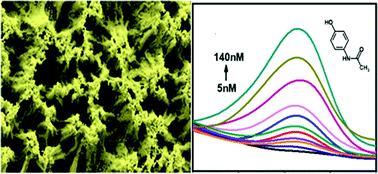An ultrasensitive electrochemical sensor for the detection of acetaminophen via a three-dimensional hierarchical nanoporous gold wire electrode†
Abstract
Acetaminophen is one of the most commonly used non-steroidal anti-inflammatory drugs worldwide. However, due to the increasing popularity of this drug, overdosing and the contamination of ambient waterways have emerged as major issues. Here, we report on a reliable, ultrasensitive, and easy-to-use sensor for the electrochemical detection of acetaminophen. This sensor employs a gold wire electrode with a unique three-dimensional hierachical nanoporous structure, fabricated using a dissolution, disproportion and deposition procedure. In consideration of optimal sensitivity and reproducibility, the most suitable nanoporous gold electrode was employed for the detection of acetamiophen among a set of nanoporous electrodes made under different reaction times. It was found that the pore size, film thickness, and electrochemically active surface area (ECSA) played major roles in the fouling resistance of the developed sensor. The ECSA of the selected sensor was increased by 15.8 times after the post-treatment. The 3D nanoporous electrode demonstrated excellent performance for the detection of acetaminophen with a low detection limit of 3.37 nM, and a strong anti-interference capability. The developed nanoporous Au electrode proved effective for the detection of acetaminophen in real sheep serum, which confirmed its promising application for medical diagnostics and pollutant surveilliance in source waters.



 Please wait while we load your content...
Please wait while we load your content...